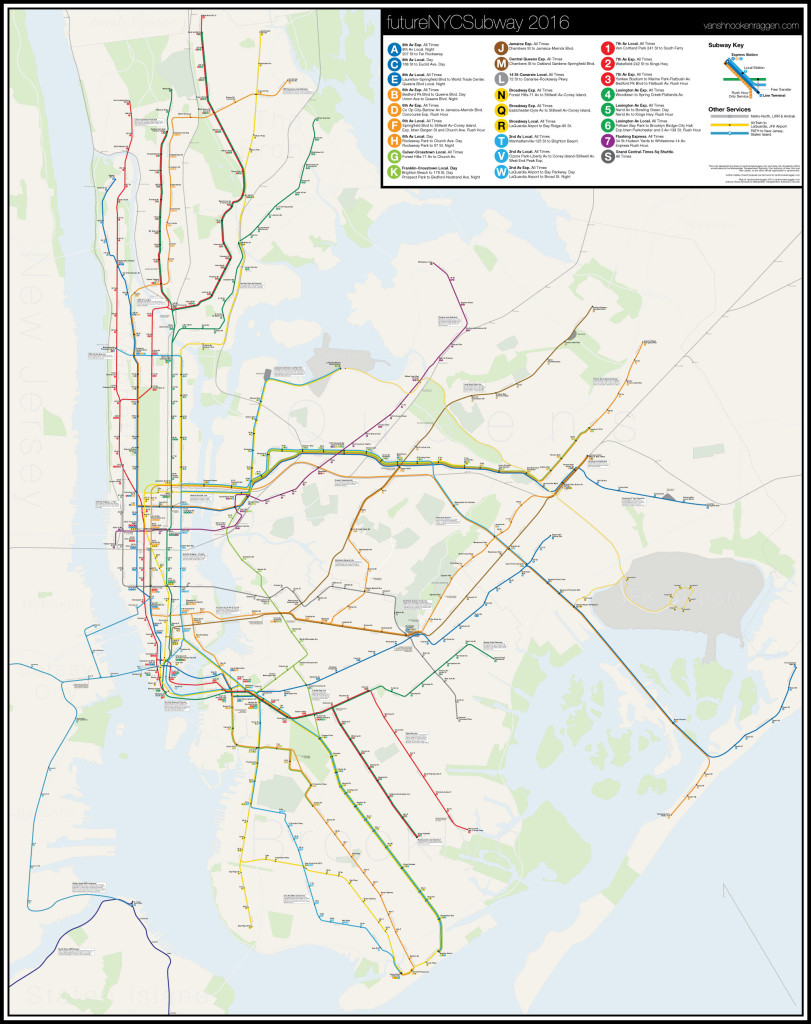
As the major subway expansion projects of the last 15 years begin to open and the big issue everyone is talking about is cost. The top 3 most expensive transit projects in the world (cost per mile) are all in NYC; East Side Access, 2nd Ave Subway, and the 7 Line extension. Furthermore the Calatrava PATH station at the World Trade Center is likely to be the most expensive subway station ever built. There is much I don’t know about the internal workings of the MTA and I would love to have someone at the state run a total audit of the MTA to find the fat that could be cut; at this point I’m willing to bet the cost problem is across the board and there will not be one magic solution to fixing it. Governor Cuomo famously forced the MTA to scale back their 2015-2019 budget as a way to curtail waist. The issue now is that he still hates the MTA and refuses to fund them even after they were able to cut billions out. If only he was serious about reforming the MTA rather than using it as a punching bag. He recent wide ranging transportation proposals seem to be directed only at subruban commuters with improvements to the LIRR, Penn Station, and a study to look at a new Long Island Sound crossing… all things that weren’t really a priority before he decided to champion them.
With this in mind I sought to plan out a system expansion which would be as cost effective as possible by addressing current service bottlenecks, train car issues, current ridership and population growth. The Queens Blvd Line is currently slated to undergo conversion to CBTC, a new signal system which will allow up to 40 trains per hour to run (current signals allow up to 30tph but do to a variety of factors this is rarely possible). CBTC is the only way that the G train can be extended back to Forest Hills or, once the 2nd Ave Subway is opened below 63rd St, 2nd Ave trains can run along Queens Blvd. CBTC will take many years to be fully installed on every subway line so focusing on the Queens Blvd Line is a good start but the full impact of the improved service will take time to be felt.
Other proposals deal with small projects with large consequences. Since the IRT opened it has been known that many of the junctions between lines, specifically the Rodgers Ave Junction at Eastern Parkway and Nostrand Ave and the Lexington Ave-149th St Junction on the 5 Line, are bottlenecks which have a serious impact of service. There have been proposals for decades to rebuild these junctions but nothing has ever been done. The Rodgers Ave Junction in particular has been a major road block to the Utica Ave Subway as it would seriously limit trains to Utica Ave and New Lots.
First Stage Expansions
2nd Ave Subway
My most recent concept for the 2nd Ave Subway deals with trunk pairing. Trunk pairing is how each of the three companies which built the NYC Subway designed their systems. The idea is simple: built two trunk lines that run through Manhattan which branch off in the outer boroughs. The branches then merge so that, for instance, riders in the Bronx can at a single station have access to trains that run down either the west or east sides of Manhattan (this was more the case when the 9th Ave elevated line still connected to the 4 train). The IND and IRT were designed this way (more so the IND which learned from the mistakes of the IRT and BMT). The BMT however was focused more on lower Manhattan and designed a system where trains would come in from all over Brooklyn and loop back over the bridges and through the Montague St Tunnel. It worked for a while until the heart of the central business district moved up to midtown. This is why there is so much abandoned subway infrastructure on the Broadway (N/Q/R) and Jamaica Lines (J/Z). This was addressed in 1968 with the Chrystie St Connection which connected the Williamsburg and Manhattan Bridges to the 6th Ave Line (today’s B/D/M trains), rerouting lines through midtown which previously only went downtown. The Broadway Line is now paired with the 6th Ave Line which due to them being a block apart in many places isn’t the most efficient pairing.
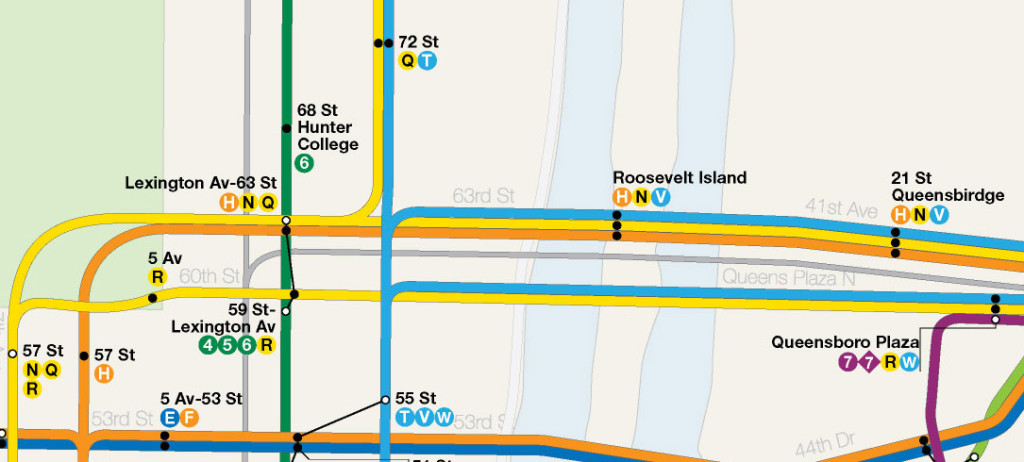
Pairing the Broadway Line with the new 2nd Ave Line would give riders a new one seat option to get to either the west or east sides of Manhattan (or rather central Manhattan and the east side). This would immediately have a major positive impact on transfers at congested midtown stations like 59th/Lexington Ave and 53rd/Lexington Ave. The Queens Blvd Line has two local service, the R and M, but would be much more effective if it was the R and a 2nd Ave train (a restored V train). The M then could then be used as additional express service past Forest Hills. With the addition of express tracks another pairing could be possible by building a new connection between the 2nd Ave Subway and the 60th St tunnel which carries the N to Astoria. The Astoria Line historically had a direct connection to the now demolished 2nd Ave Elevated line and restoring this connection would address many of the transfers at 59th St/Lexington Ave.
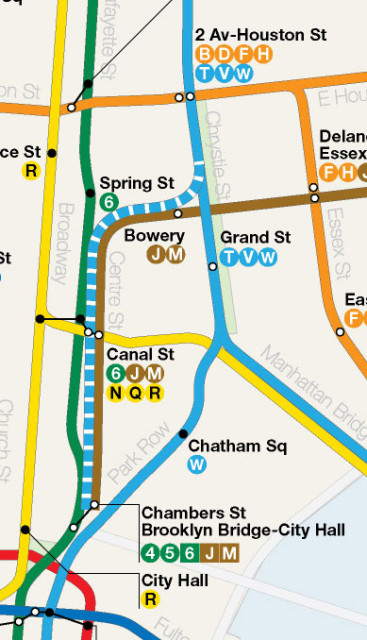
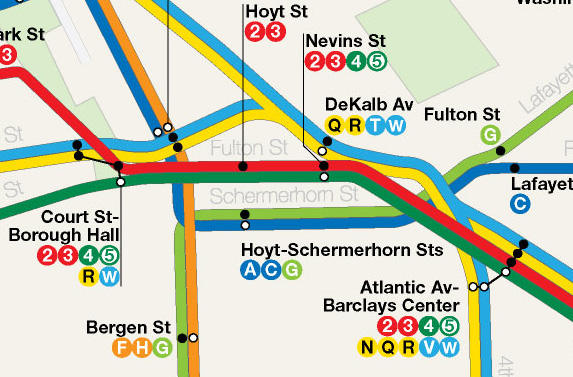
At Houston St the 6th Ave Express trains, which currently run over the Manhattan Bridge, would instead be extended to Williamsburg via a new tunnel to South 4th St for a new line covered below. This frees up space on the Manhattan Bridge for 2nd Ave trains so at DeKalb Ave each Broadway-2nd Ave train pairing would meet and run off to their respectful branches: N/R trains along 4th Ave would be joined by 2nd Ave local and express trains taking over from the D on the West End Line (with peak direction express) while the Q and T run local-express to Brighton Beach.
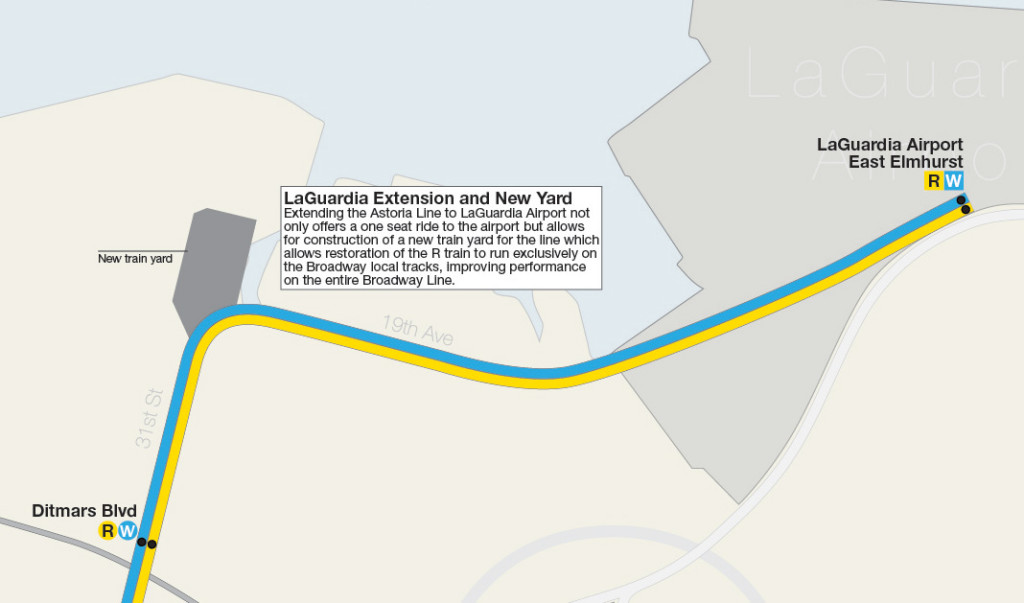
The final part of the plan is seemingly unrelated to the 2nd Ave Subway at all but would have huge consequences in terms of efficiency. Historically the R ran from Bay Ridge to Astoria along the Broadway local tracks while the N ran express and connected to the Queens Blvd Line. This was reversed because the R had no direct access to a train yard (which meant that if a train needed to go out of service or more trains added to make up for a disruption the R trains needed to make long runs along other lines to reach their lines). Extending the Astoria Line to LaGuardia Airport would mean that a new yard could be built north of 20th Ave on land owned by ConEd which is currently fallow. This new yard would allow R trains to return to the Astoria Line. Why is this preferred? This means the R train would run exclusively on the local tracks while the N would share the express with the Q but never have to merge with local tracks along Broadway (this merging causes delays and caps the capacity of the Broadway Line). The N would return to Queens Blvd via the 63rd St tunnel and Astoria and Bay Ridge riders would now be able to see increased and more reliable service on the R train. Riders on the Lexington Ave Line would need to adjust their commute as 59th/Lexington Ave would only allow a transfer to the Astoria Line so all Queens Blvd bound riders would need to transfer at 51st/Lexington Ave. Additionally any Queens Blvd bound rider could also take the 2nd Ave Line instead of the Lexington Ave Line and transfer across the platform at 63rd/Lexington Ave. Segregating transfers would have an overall benefit to service and congestion throughout midtown. Having an Astoria-2nd Ave branch would also remove the need for many transfers at 59th St/Lexington Ave to further reduce congestion.
With funding for Phase 2 of the 2nd Ave Subway cut from the still unfunded MTA 2015-2019 budget it seems almost futile to talk about the future of the project. As with all my past designs looking past Phase 2 would extend a branch west under 125th St to Broadway and a branch north to replace the 5 train to Dyre Ave. The city, in using designs for the 2nd Ave Subway which date to the 1970s, has permanently stunted service to the Bronx on the east side of Manhattan. Only two service can run along 2nd Ave, both local, which means that expanding subway service to under served areas like 3rd Ave or Throgs Neck is virtually impossible. 2016 is not 1971 and it is imperative that the sections south of 63rd St are built as a 4 track trunk line. The additional track will be under used for the foreseeable future but it is important to have it when future demand can fill the void; if the tracks of the 2nd Ave Line are designed properly then it would even be possible to terminate trains from Brooklyn in midtown. 4 tracks south of 63rd St to Grand St would allow better utilization of the East River tunnels between Manhattan and Queens which are already at capacity.
IRT Junction Rehabilitation and the Utica Ave Subway
Since the day it opened the IRT has had capacity and congestion issues. Being the first subway in New York it was designed conservatively to save money and much of these design choices still haunt the system today (you will notice narrower cars on the numbered lines for instance). While the A Division (as the IRT is known internally) was the first to see countdown clocks and CBTC (or whatever similar system the MTA ended up installing) to help with congestion there are some physical limitations which effect capacity. There are two major junctions on the IRT where the 2 and 5 trains merge and their issues have been know about since the beginning. The Rogers Ave Junction in Brooklyn where the Nostrand Ave Subway merges with the Eastern Parkway Subway requires local trains to cross in front of express trains. This limits capacity on the New Lots Line (3 train) and in doing so also makes any extension for the Utica Ave Subway impractical. In the Bronx where the 2 and 5 merge again at 149th St there is an extremely sharp S-curve connecting the Lexington Ave Line with the White Plains Rd Line. This was done to eliminate the need for transfers from the 2 to the 4/5 and this service is immensely popular.
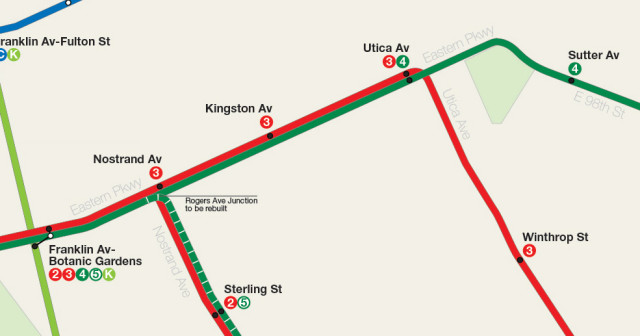
Because both junctions directly impact the entire A Division any delay at either one backs up the entire system. This is why train pairing is so important to the IRT and why the 2/5 runs together in the Bronx and Brooklyn. Reconfiguring these junctions would not only speed up service on the entire system but also enable more trains to run at higher speeds as well as open the door for the Utica Ave Subway.
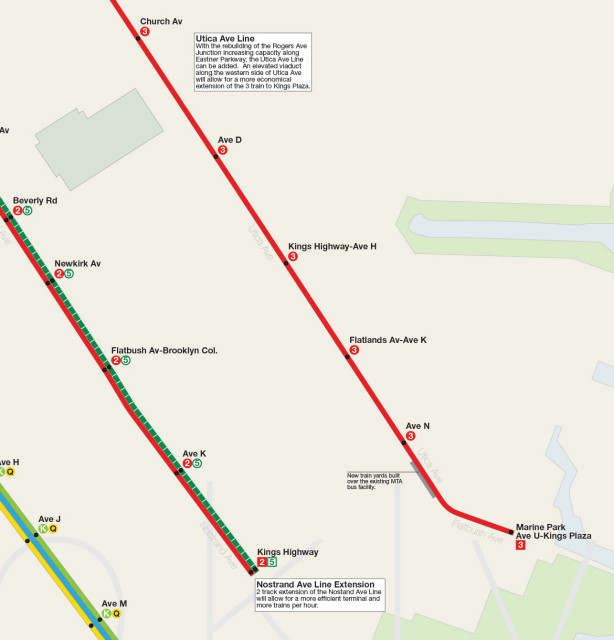
The Utica Ave Subway in this plan would extend the 3 train south to Kings Plaza. In all of my earlier plans I had extended the 4 train down Utica Ave but a closer inspection of how the tracks are aligned at the Utica Ave station shows that it would be much simpler to extend the local tracks south; the 4 express train would take over to New Lots Ave, which should also be extended south through the existing train yards to Spring Creek-Flatlands Ave to support the Spring Creek redevelopment. The Utica Ave Line would run in a tunnel until Rutland Rd where it would ascend and run on an elevated viaduct south to Kings Plaza. The viaduct would run along private land to be taken by eminent domain and designed so that future private development could be built around it. This is the only economical way to build the line and one that would use direct land resale to offset costs.
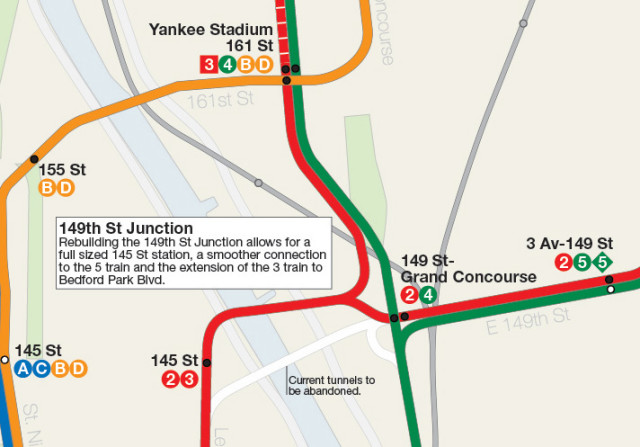
At 145th St in Harlem the 2 train peels off into the Bronx while the 3 terminates at 148th St. The 145th St station, due to the junction with the 2 train, could not be extended to fit longer train sets. At Grand Concourse the 5 merges with the 2 on a tight S-curve. A new alignment would remedy both bottlenecks. Beginning at 138th St at Lenox Ave the tracks of the 2/3 would drop down and run to a new station built below the current 145th St station which would be large enough for a full train set (The current station would still exist but only be used to connect trains to the 148th St Yards and the 148th St terminal would be closed to passengers except for the odd shuttle service). The new tunnel would swing under the Harlem River to 150th St where it would split with the 2 train connecting to the existing 149th-Grand Concourse station and the 3 train swinging up to merge with the 4 train under Franz Sigel Park. The 5 train merge would be rebuilt so it would occur between Grand Concourse and 3rd Ave stations so that the curve of the tunnel would allow for much faster/smoother merges. Service on the White Plains Rd Line (2/5 trains) would be sped up and the 3 train would allow for double the service on the Jerome Ave Line (4 train) up to Bedford Park Blvd-Lehman College where the 3 would terminate (the junction between the main line and yard tracks would also have to be rebuilt to eliminate grade crossings). Furthermore between 161st-Yankee Stadium and 167th St the track bed of the line expands where the 9th Ave elevated line once merged. This extra space would then be used for layup tracks so that 3 trains could terminate late night at Yankee Stadium. This 3/4 train pairing would mimic the 2/5 pairing and allow for service adjustments on the fly.
Rockaway Branch Line and IND Queens Blvd Line Extensions
Having only one trunk line subway serving the heart of Queens is a major problem but even worse is that because it was designed to have branches the trunk line doesn’t run efficiently. Famously the Archer Ave Subway extension of the E train was designed to run southeast to Laurelton along the LIRR Atlantic Branch ROW and so the current terminal at Parsons Blvd was not designed to deal with current demand; at rush hour there are a number of E trains which must run out of 179th St. With the addition of the 63rd St Tunnel in 2001 there are even more branches feeding into the Queens Blvd Line which are forced to terminate at Forest Hills or in Jamaica; with two Manhattan-bound local trains terminating at Forest Hills-71st Ave there is no room to run Crosstown G trains past Court Sq. Extending existing branches and building new ones will actually improve overall service along the line but it needs to be done correctly.
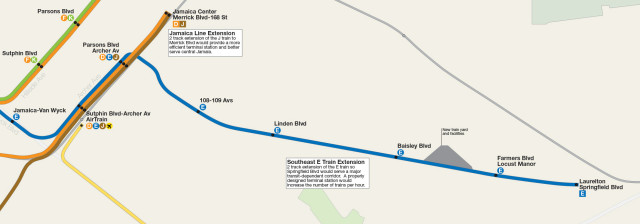
The two most important and needed extensions are the E southeast to Laurelton-Springfield Blvd along the existing LIRR ROW (the subway would actually replace the LIRR service which would be shifted east through St. Albans). This would allow for a proper terminal that would easily handle to high demand along the E line and include a new train yard/shops at a plot of land known today as Railroad Park (which was left as a space for future train storage). The second extension would be off the local track at 63rd St-Rego Park and run along the Rockaway Branch ROW to connect with the A train to the Rockaways. Currently the best set up would be for the M train to make this run but with the addition of the Queens Superexpress Line from the 63rd St Tunnel along the LIRR Main Line to Rego Park the Rockaway Line would offer both local (via Queens Blvd) and express service with trains to 6th Ave and 2nd Ave. (On the service map shown I have 6th Ave H trains running express from 63rd St to Rockaway Park and 2nd Ave V local trains terminating at Liberty Ave. Actual service would depend on demand.)
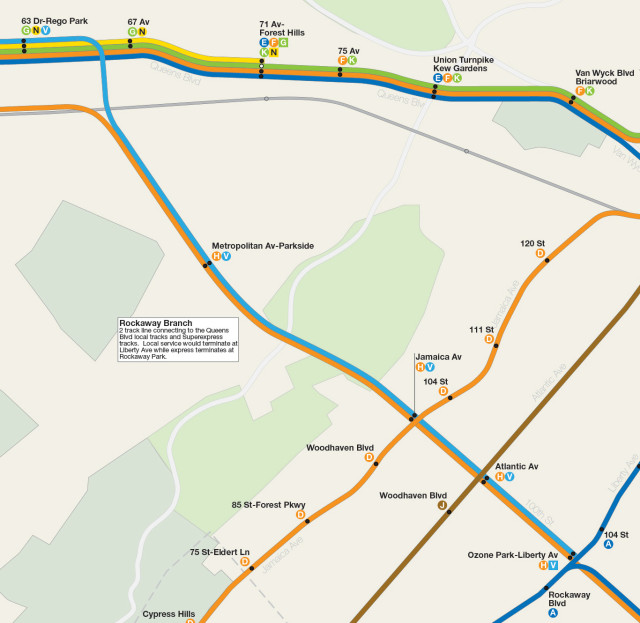
These branches not only offer new service to under served areas of the city but also free up terminal space along Queens Blvd at Forest Hills and 179th St. This allows for the return of the Crosstown G train to run to Forest Hills. A future extension of the Hillside Ave Subway from 179th St to Queens Village-Springfield Blvd should also be looked at do to the high demand coming from bus transfers. Both the E train extension and the Superexpress-Rockaway Branch Line extension would be above ground along existing ROWs to reduce costs. A Hillside Ave Subway extension would be costlier because of both tunneling construction and managing the high water table in the area. It might be possible to build an elevated line but the largely residential nature of the area would discourage this.
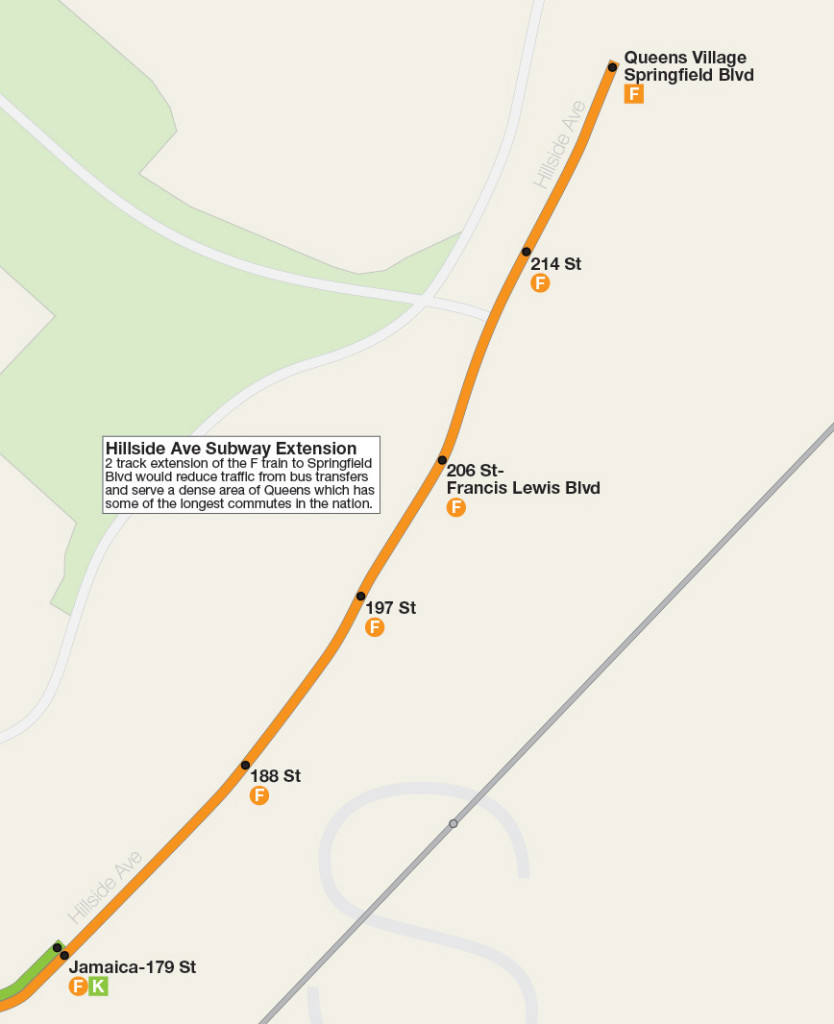
Franklin Ave Subway – K Train
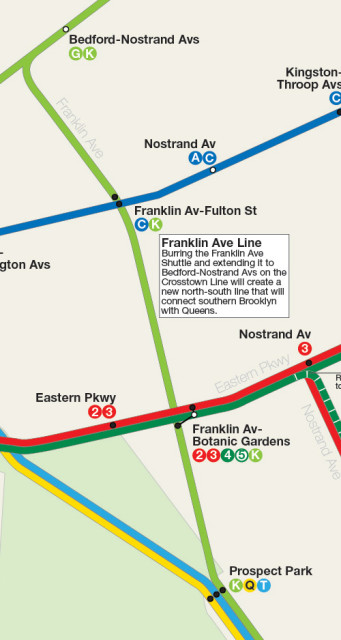
Because the Crosstown Line was never designed to terminate at Court Sq all Crosstown trains would need to be run out to Forest Hills. As I outlined above with the addition of CBTC the Queens Blvd Line can handle such an extension of existing G train service. With both G and K trains now extended from Court Sq some trains would need to run express along side the E and F trains. The Crosstown K Express would terminate at Jamaica-179th St and allow for rush hour F trains to run express all the way to 179th St; local service past Forest Hills has never been popular due to riders switching to overcrowded express trains so making the extra Crosstown service express would pick any slack. Night time service would be reduced to a shuttle between Bedford-Nostrand and Prospect Park unless it proved more popular than the G train.
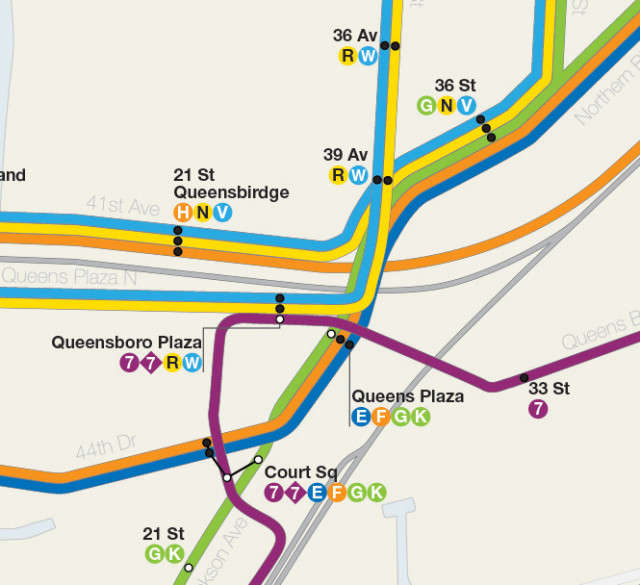
Second Stage Expansions
Bushwick-Queens Trunk Line
Way back in my very first futureNYCSubway series I proposed bringing back the the gargantuan South 4th St Subway with connections to 2nd Ave, 6th Ave, and 8th Ave via Worth St, as well as branches out to central Queens, Utica Ave, and Broadway Junction. Thinking big is fun but reality has a way to raining on your parade. But the need for better transit to Williamsburg is as important as ever (how we all wish now that at least one of those IND tunnels had been built) and more importantly is cross-borough connections. Better Brooklyn-Queens and Queens-Bronx connections are needed and at the same time the East River crossings between Queens and Manhattan are reaching their capacity. With a 2nd Ave service using the 63rd St Tunnel all the tunnels above 42nd St will be maxed out. The new Bushwick-Queens Trunk Line is a staged plan which will try to address these issues and more in the most affordable way I can think of.
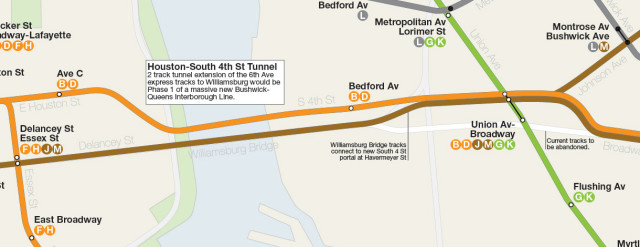
As part of the 2nd Ave Subway plan I outlined above I mentioned shifting the 6th Ave express trains from the Manhattan Bridge through a new East River tunnel to Williamsburg. This is Phase 1. This new 2 track tunnel will continue east under Houston St with a station between Clinton St/Ave B and Pitt St/Ave C then make a southeastern turn through the Baruch Houses along a path with will run under existing open space to where Rivington St would meet the FDR Dr. Headed under the East River to South 4th St to a station between Berry St and Bedford Av and then running to Union Ave where it will terminate using the existing South 4th St station shell at Broadway on the G.
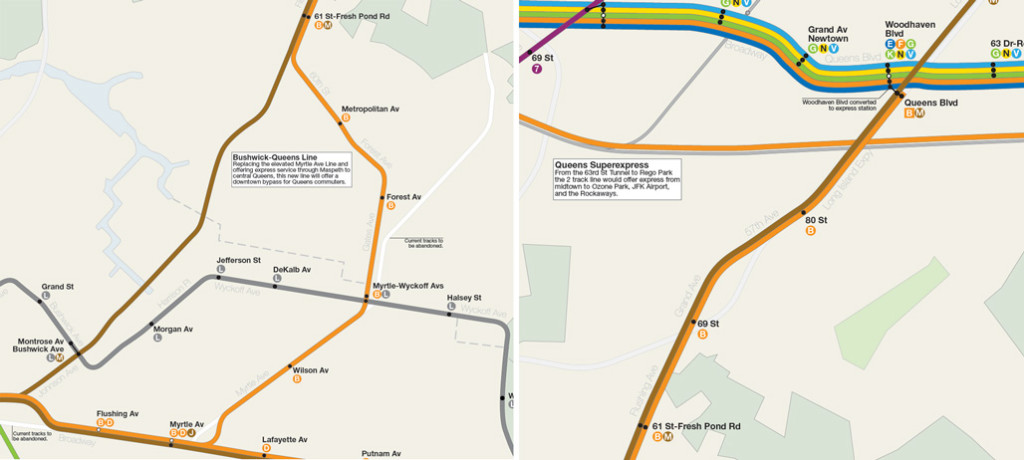
Phase 2 extends the line from Union Ave where will split into a 2 track tunnel under Johnson Ave, which will run past Bushwick Ave (with a transfer to the Montrose Ave L train station) and then ascend and run above ground along the existing freight ROW from Morgan Ave to Flushing Ave acting as express tracks. A 4 track tunnel (space for 4 but only 2 will be built for this stage) will run from Union Ave to Myrtle Ave along Broadway. At Broadway and Myrtle a 2 track tunnel, the local tracks, will run under Myrtle Ave to a Cypress Ave where it will turn northeast under Gates Ave and then north under Forest Ave where it will run to Metropolitan Ave, turn north under 60th St and continue to Flushing Ave meeting up with the express tracks. The now 4 track subway will run northeast under Flushing Ave and Grand Ave to 57 Ave where it will continue east under the Long Island Expressway to Queens Blvd. At Queens Blvd the local tracks will terminate and provisions will be left for the express tracks to extend further east. At this point Woodhaven Blvd station will be converted into an express station. This phase will allow for the removal of the elevated Myrtle Ave Line tracks out to the existing Metropolitan Ave terminal. Non revenue tracks will connect the new subway to the existing Fresh Pond Yards.
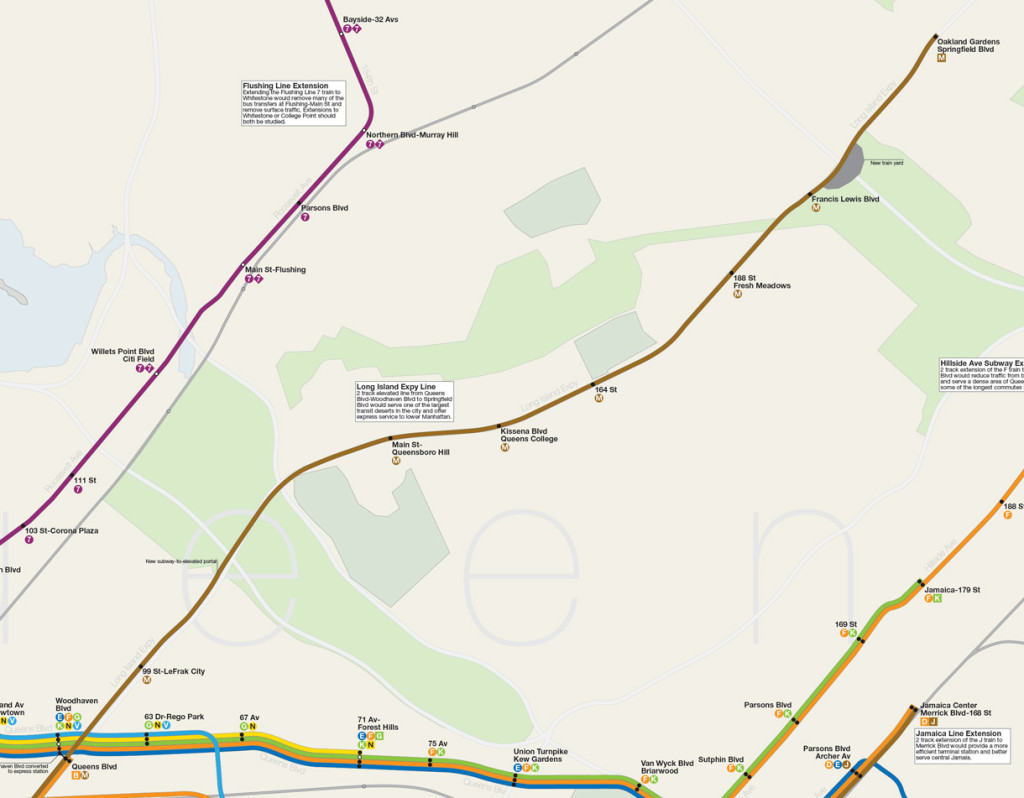
Phase 3 will extend the express tracks east along the Long Island Expressway. The most affordable solution is to run them along a concrete elevated viaduct running along the median of the highway much the same way the AirTrain runs long the Van Wyck Expressway. The line will be 2 tracks with island platform stations. The most difficult part of this stage will be placing the needed train yard/shops. While there is space inside Cunningham and Alley Pond Parks it would most likely cause a backlash against the project so it might be possible to build a yard either above or below the interchange between the Long Island and Clearview Expressways. Alternatively the yard could be placed underground around Francis Lewis Blvd where there is abundant park space that could be restored after.
The first three phases replace the existing Myrtle Ave elevated line and create a new express subway for central Queens which bypasses Long Island City and midtown Manhattan but also connects to the Queens Blvd Line should riders need to transfer. This line serves a large swath of the city far from the subway and takes pressure off of midtown transfer stations. Removing the Myrtle Ave elevated will mean that J/Z trains will no longer have to wait for M trains to switch in front of them at Myrtle Ave which will greatly speed up service.
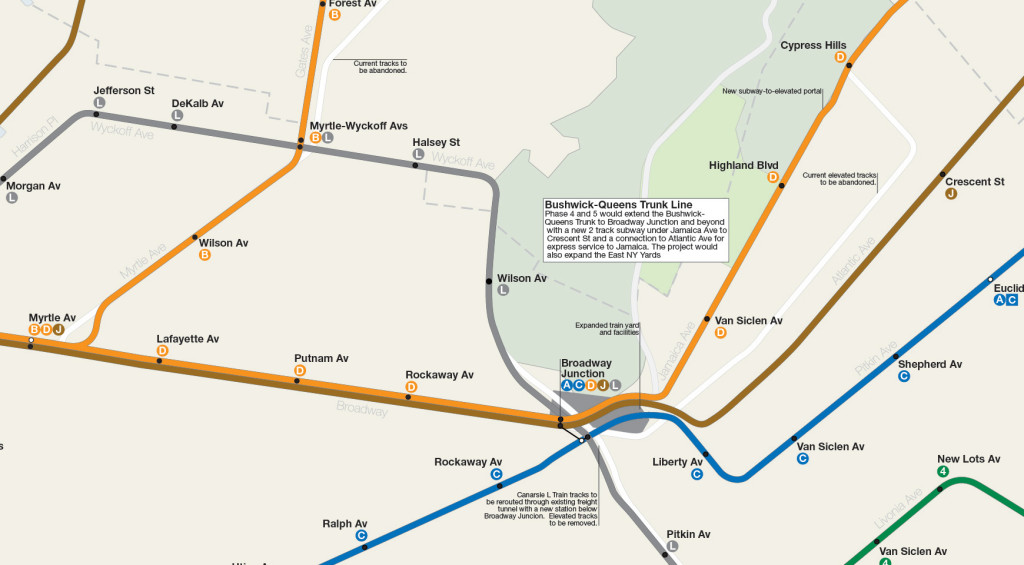
Phase 4 would radically change the Jamaica Line and is left for last as the existing elevated structure (which is already some of the oldest continually used transit infrastructure in the city) will reach the end of its useful life. The Jamaica Line is seeing spillover growth as gentrification moves east along the L train and by the time the first three stages of the B-Q Trunk is opened the demand should be in place to expand. The forth stage has three parts to be built at the same time: extending the 4 track subway from Broadway and Myrtle Aves to Broadway Junction, expanding the existing East NY Yards of the J train so it can handle longer trains, and connecting the tracks of the Williamsburg Bridge to the South 4th St Subway at Havermeyer St. The grade from the bridge to the subway will be a bit steeper than the trains on the Manhattan side of the bridge face so it is possible that the highway ramps on the bridge will have to be moved in order to fit the portal. This connection means that the elevated track from the bridge to Broadway Junction can be completely removed and that northern Brooklyn and central Queens will each have train pairs to take them either downtown to Chambers St or to midtown via 6th Ave.
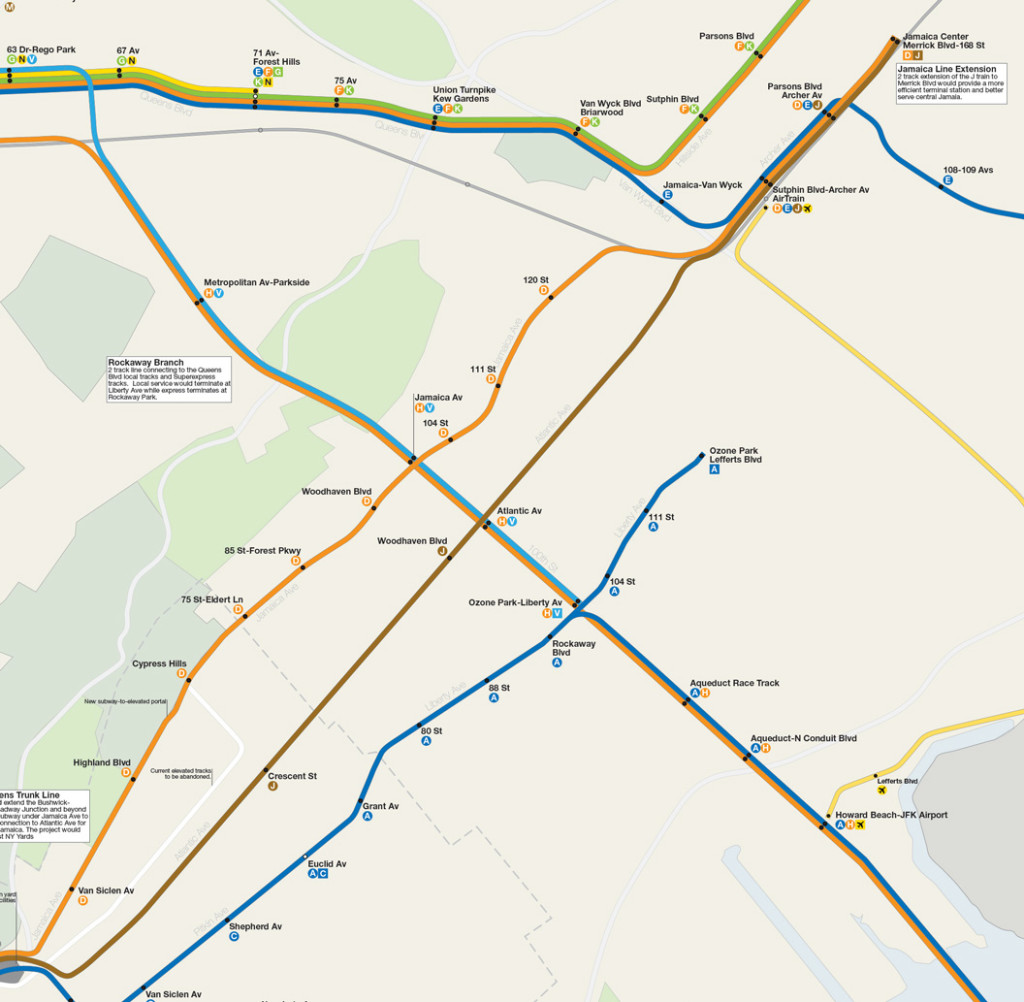
The fifth and final phase will extend the local tracks from Broadway Junction under Jamaica Ave to a new portal at Crescent St/Jamaica Ave to connect with the existing elevated tracks at Cypress Hills station. The S-curve along Crescent St is a major bottleneck on the J/Z train which necessitates slow travel and increased wear and tear on the trains. Removing this section and replacing it with a subway with only 2 stations (replacing 5 stations which are rather close together) will improve service drastically. The express tracks will be extended south to Atlantic Ave where they will run superexpress to Jamaica along the LIRR Atlantic Ave Line which is slated to be turned into a shuttle once East Side Access opens to Grand Central Terminal. The superexpress tracks will connect to the lower level of the Archer Ave Subway which itself will be extended one station to the east to Merrick Blvd where a larger terminal station will be built to handle the multiple service.
An additional part of this expansion would be to replace the elevated L train tracks over Broadway Junction and reroute the L through the existing freight tunnel which runs parallel to the L. Between the Wilson Ave and Bushwick-Aberdeen stations the L would connect to the other tunnel and bypass Bushwick-Aberdeen (which would be abandoned), a new station would be built under Broadway Junction connecting the new J station to the existing A/C station, then it would surface in the trench below the existing elevated tracks and run to New Lots Ave where it would connect back to the elevated tracks. The Atlantic Ave and Sutter Ave stations would be replaced by a single station at Pitkin Ave.
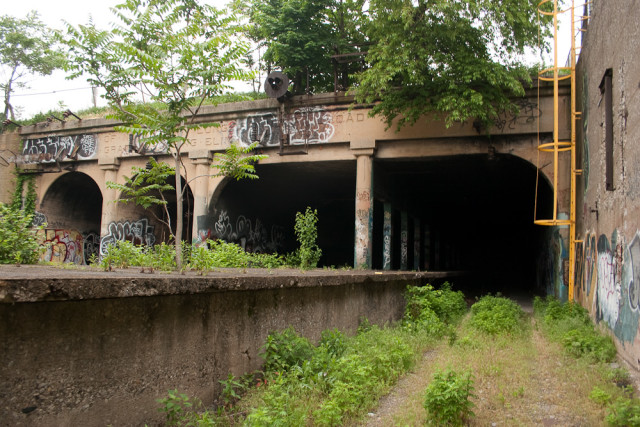
What will then exist is a brand new system which replaces the bottlenecks of the elevated Jamaica Line with a modern subway that better serves the needs of Brooklyn and Queens riders. The staged construction schedule allows for immediate relief of current congestion in Williamsburg while ridership grows further out. Riders from Jamaica will have a one seat express ride to lower Manhattan as well as a one seat ride to midtown for riders who live in Woodhaven, East New York, and Richmond Hill. Williamsburg, Bed-Stuy and Bushwick will lose their elevated trains and gain better options than only the L train. Central Queens will get an express train to lower Manhattan and a second alternative to midtown avoiding the congested LIC-Midtown tunnels. Built in stages the system can also be adjusted as new demand surfaces as once fast new inter-borough connections are opened riders will have new options about where they live and work.
PATH to Staten Island
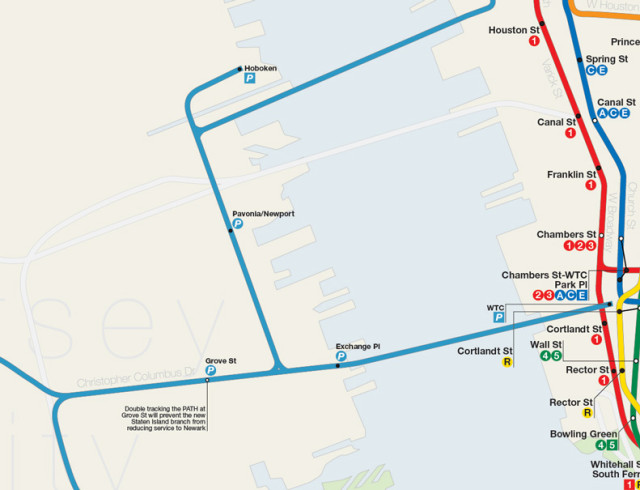
In my last futureNYCSubway update I laid out a plan for using a new Cross-Harbor Tunnel to give Staten Island commuter rail access to greater New York City. With the recent plans for the new Amtrak “Gateway Tunnel” under the Hudson River to an expanded Penn Station coming in at at least $14 billion it would seem that any cross harbor tunnel, which would serve a fraction of the ridership and freight tonnage, would be of similar cost (while a large chunk of the Gateway Tunnel cost is actually for non tunnel infrastructure like expanding Penn Station any tunnel to Staten Island and New Jersey would require expensive support infrastructure as well so costs, while less than Gateway, would still be significant). Because of current bottlenecks in downtown Brooklyn any subway tunnel to Staten Island via Brooklyn (or Manhattan for that matter) would be either detrimental to current service or require expensive new tunneling before any underwater tunnel could be built.
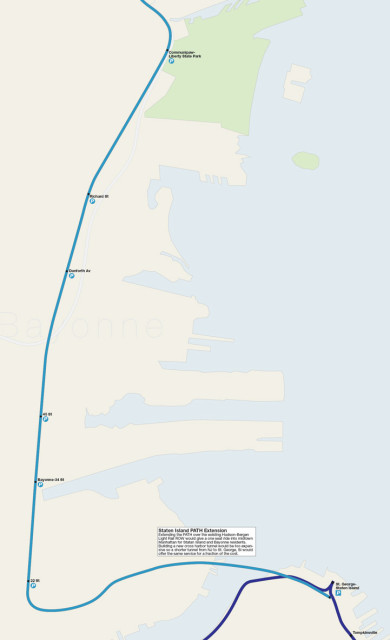
This leaves the PATH train as the only service which could easily handle expansion and offers a one seat ride to both midtown and downtown Manhattan. At first glance it may seem odd that New Yorkers from Staten Island would want to travel through New Jersey to get to Manhattan but that is taking a NY/MTA-centric view of what is a regional transportation problem. Islanders travel through New Jersey regularly via the Port Authority owned Bayonne, Geothals, and Outerbridge crossings. A PATH extension would also take cars off the bridges by offering direct transit access to job centers outside of Manhattan in Jersey City and Newark (and possibly Liberty Airport should that extension ever be built). These factors give more weight to a Port Authority built project than to an MTA or NYC related extension.
The key to keeping the extension affordable is using the HBLR tracks from Communipaw station to 22nd St. The Port Authority would purchase the tracks from the HBLR; the West Side Branch would be kept in operation but the single track 8th St terminal in Bayonne would be abandoned. The stations would be expanded to fit PATH trains (with high level ADA compliant platforms and the line could either be converted to third rail power OR new dual power trains could be purchased which switch from third rail power to overhead catenary power similar to how Blue Line trains work in Boston. At the north end a new tunnel would be built connecting the PATH along Christopher Columbus Dr to Communipaw. To avoid a bottle neck at Grove St where trains switch from Hoboken/33rd St and WTC bound tracks the new connection would expand Grove St station to 4 tracks with 2 island platforms. At 22nd St in Bayonne the line would wind east and follow the freight cutoff tracks through Constable Hook where it would diver below the Kill Van Kull into a deep bored tunnel to Richmond Terrace at St. George. The SI PATH line would most likely terminate at 33rd St as the SI Ferry would still provide fast service to lower Manhattan. A PATH line to SI would also be a boon for Bayonne as a one seat ride to Manhattan would property values.
Third Stage Expansion
IRT Nostrand Ave Extension
With the construction of the Utica Ave Subway the Nostrand Ave Line (2/5 trains) would see ridership relief so an extension south is less important. The biggest issue facing the Nostrand Ave Line is capacity at Flatbush Ave-Brooklyn College as the station was not designed to be a terminal, an extension south was planned but never built. Extending the line south would address the terminal capacity issue and give residents of southeastern Brooklyn an alternative to the Brighton Beach Line. An extension south would be on the expensive side; the line would have to be in a tunnel the entire route due to the densely developed residential neighborhoods in the area and the tunnel would need to be designed to deal with the high water table in the area. The most economical extension would be to Kings Highway with a possible station at Ave K. The terminal at Kings Highway would have modern storage tracks past the station which allows for more trains per hour to be turned and run.
IND Concourse Line Extension to Coop City
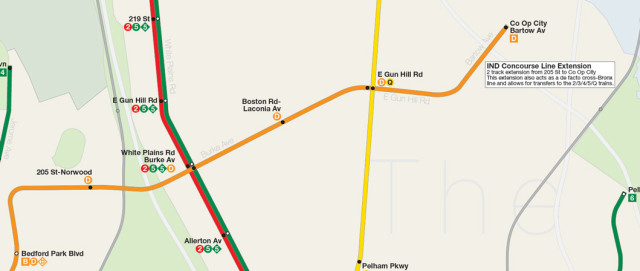
While the Bronx has some of the best subway coverage per borough there are still some holes that need addressing. Because the 2nd Ave Subway is not being built with an express track the options for new service in the Bronx is limited. The only line that can be realistically extended is the IND Concourse Line which was designed for an extension east after Norwood-205 St. The extension was originally rendered moot when the city bought the Dyre Ave Line from the NY, Westchester & Boston RR. The Dyre Ave Line would best be served by extending the Q up from 2nd Ave so that 5 trains no longer have to split service between it and the more heavily used White Plains Rd Line. With the opening of Co Op City there was talk of extending the 6 train from Pelham Bay Park to service the new development but I feel that extending the D train, while more expensive, would ultimately serve the Bronx better. The Bx12 Select Bus Service was the first BRT style service the MTA opened between Co Op City and Inwood-207 St and has proven a massive success. The need for better cross-Bronx service is clear however the costs associated with building any kind of cross-Bronx subway are prohibitive; an ideal cross-Bronx line would connect as many lines as possible and be best located around either 149th or 161st streets. An extension of the Concourse Line would parallel the Bx12 service from Coop City to Fordham Rd as well as connect to the Dyre Ave Q train, White Plains Rd 2/5 trains and Jerome Ave 4 train, finally connecting the A at 145th St. While not perfect it would be the most economical crosstown type subway service.
IRT Flushing Line Extension
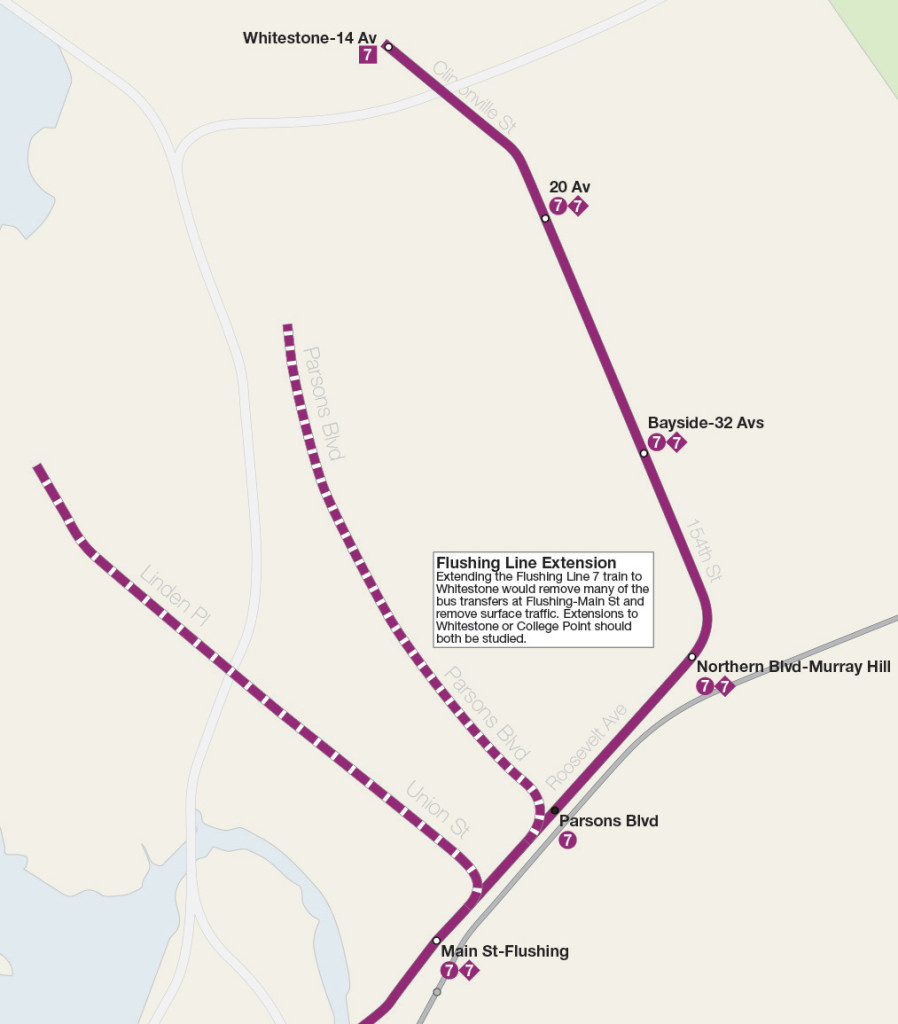
Flushing being the major transit hub that it is needs an extension of the 7 train east to reduce the bevy of bus lines that terminate in downtown Flushing. Extending the line east to Northern Blvd would probably suffice but an extension north to Whitestone should be considered. While College Point is more densely developed than Whitestone extending the 7 train north from Flushing-Main St would be complicated and expensive. The best route for the extension in terms of bus line and population density would be along Parsons Blvd but an extension further east along 154th St would better server all of Flushing. A 154th St alignment may run into more resistance from the more suburban residents of Murray Hill and Whitestone so it’s hard to say which alignment would be best. With the opening of East Side Access the Port Washington Branch LIRR which runs through Flushing will see more trains run and also trains terminating at Grand Central Terminal. Because of this and also the possible implementation of the proposed Freedom Pass (which is very much in concept phase at this point) any extension of the 7 train to Bayside, as originally proposed, would be needlessly redundant.
10th Ave L train
Far West Side development will be adequately served buy the 7 train at 34th St-Hudson Yards for some time. The issue won’t be that the 7 train can’t handle the crowds but can Times Sq and Grand Central handle the transfers. These are the most heavily used stations in the entire system and transferring at either can be intimidating and time consuming. As the Far West Side starts to build out an extension of the L train from 14th St should be considered as a second option for riders to transfer. Additionally an extension of the L, even only as far as 34th St, would allow for a new high capacity terminal to be built which would allow the L train to fully utilize CBTC which was installed but is capped due to the por layout of the current terminal at 8th Ave.
Service Changes
It’s hard to predict how ridership will react to all the service changes proposed but there are smaller improvements which will only be applicable if these expansion projects move forward. When 6th Ave express trains are rerouted to Williamsburg via South 4th St the need for the current 6th Ave M train will disappear. In my plan I’ve replaced the M with the H train as it would be extended to Rockaway Park, traditionally home to the H train. The H, running local along 6th Ave, is now free to provide extra service along the IND Culver Line (F/G). Local politicians have been calling for express F train service for years even though the numbers don’t justify it. Adding an extra service would allow the H train to run express or even day time local while the F runs day time express and night time local.
With the reorganization of the Broadway Line and Queens Blvd branches, Queens-bound riders on the Lexington Ave Line will have to change where they transfer. Combined with the planned growth of Midtown East it would be beneficial to build new express platforms at the 51 St station where the Lexington and the 53rd St Lines meet. Adding express platforms on the three major midtown stations on Lexington Line would reduce the need for local-express transfers at congested stations like Grand Central and 59th St. This has precedent as the express platforms at 59th/Lex were added in 1962 for this very purpose. Riders transferring to Queens-bound trains would be segregated by station: 7 train at Grand Central, E/F at 53rd St, and R at 59th St (with the free connection to 63rd St there is also the transfer to the N to Forest Hills).
The plan is not perfect for all since returning the F to the 53rd St tunnel would require a rider to transfer to the G train at Queens Plaza in order to reach any of the local stations between Queens Plaza and Roosevelt Ave. This reduction of service would be offset with the introduction of the 2nd Ave V local train which would use the 63rd St Tunnel; thus any rider coming from Midtown East could avoid the Lexington-Queens transfer all together and just take one train, the V, between work and home. Again, this kind of radical service change will cause some confusion at first but in the long run will better reduce congestion and give riders more options.
The Bushwick-Queens Trunk Line would reconfigure how the Jamaica Line serves riders by turning it into a two-service superexpress line with M trains running to Woodhaven Blvd and on to Springfield Blvd and J trains running express to Broadway Junction and then to Jamaica Center via the LIRR Atlantic Ave Line which would be converted to subway service. The 6th Ave express trains would run local with B trains running along Myrtle Ave (replacing the current M train) and the D train taking over the currently local J train along Jamaica Ave. The assumption I’m making here is that the local lines would be better served by 6th Ave service as is evidenced by the growth along the M train when it was rerouted along 6th Ave in 2010. The J/M express trains would be focused on providing high speed service to lower Manhattan from central Queens neighborhoods which currently have hour plus commutes downtown. The transfer at Union Ave/South 4th St would also give these riders a fast alternative route into midtown via 6th Ave which would further reduce crowding though Queens-Manhattan tunnels. Track connections would also allow this configuration to be reversed if local residents find J/M local service more favorable and B/D trains would run express to Queens.
The proposed Freedom Pass would be the most economical way to expand service to underserved areas of the city by giving riders a discount on LIRR and Metro North stations within the city and offering a free transfer to the bus/subway network. When the subways were being built in the early 20th century they were done so with a healthy spirit of competition with the private railroads at the time. Now that all these services are under the umbrella of the state run MTA it only makes sense to strengthen the intranetwork connections. Expanding subways along existing LIRR and Metro North right-of-ways makes sense in terms of land acquisition costs but still requires expensive new infrastructure. Already the MTA is looking at new Metro North stations along the Amtrak-Northeast Corridor through eastern Bronx. As I noted above the 2nd Ave Subway lacks an express track which limits the amount of new service it can provide to the Bronx. With the addition of new stations on the White Plains Line a Freedom Pass could offer an affordable alternative to expanding subway service. The 7 train famously was intended to be extended east to Bayside, Queens but with the Freedom Pass this extension would be useless as the Port Washington Branch LIRR would offer faster service to Grand Central and Penn Station than the 7 train.
Finally I’ve thrown in an expansion of the AirTrain which is partly based on Gov Cuomo’s plan for a new line from Willets Point to LaGuardia Airport (which I looked at a year ago). While I much prefer an extension of the Astoria Line I think a connection between the LaGuardia branch and JFK branches of the AirTrain would be an interesting way to create a cross-Queens transit line which would fill the gaps between the subways. The AirTrain, being its own system and costing an additional fee, could serve cross-Queens riders better than an extension of any subway line which would be hard to justify cost wise. Running along the Van Wyck Expressway and through Flushing Meadows Park the extension could be built for relatively cheap as it would not require expensive tunneling.

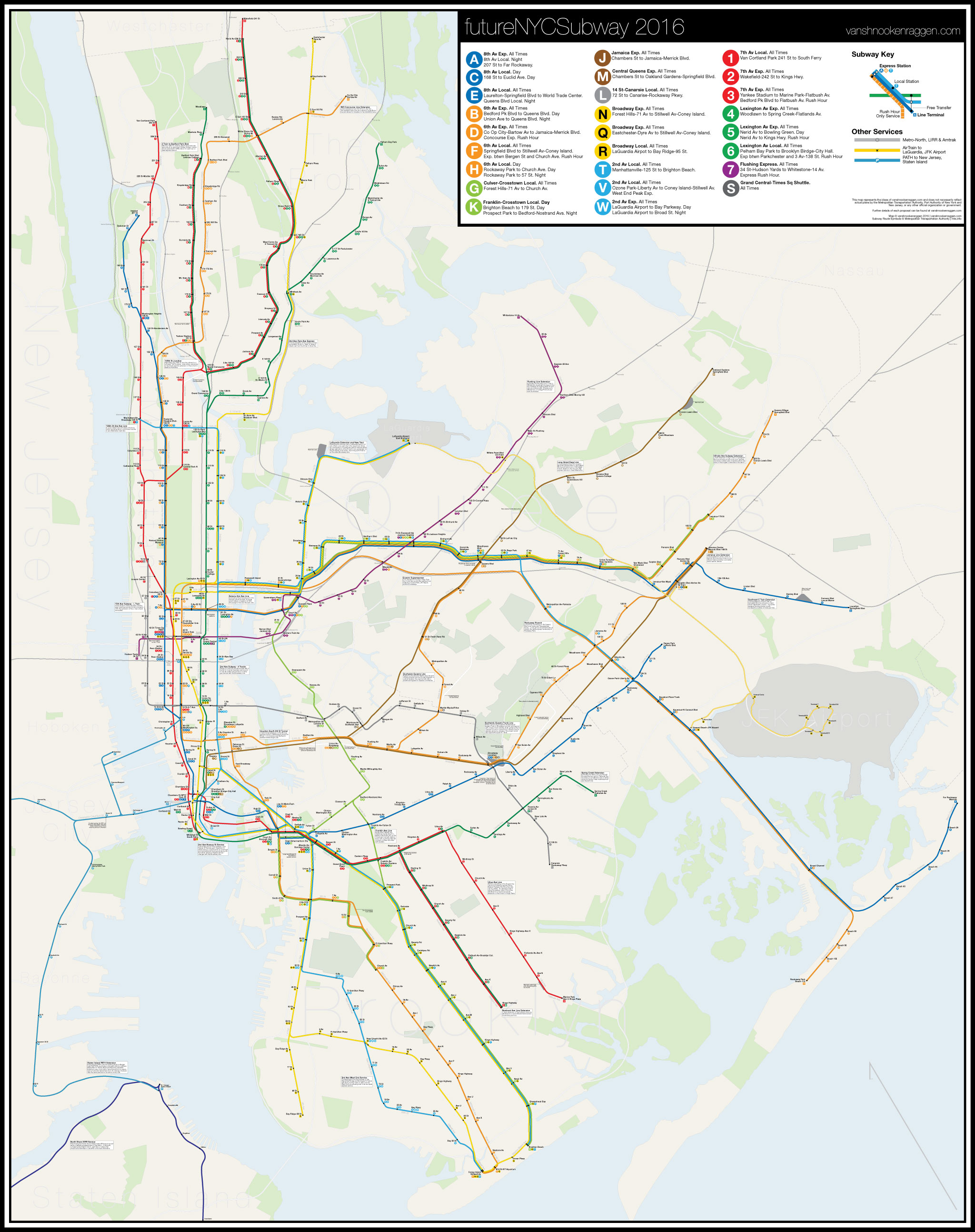

The easiest way to extend the subway to Coop City is to extend the Dyre line on an el in a circle from the Dyre terminus clockwise through some industrial wasteland areas and then south into Coop City. No tunneling, not a big distance, no eminent domain.
I swear i look up to u when i get older lol
I always in visioned the #3 being rerouted to Far Rockaway via a Nostrand and Flatbush Avenues (Kings Plaza) Extension. The benefits of such an extension would be that it will provide another line into the Rockaways and it would cover a larger section of this area. Plus you get the benefit of the Kings Plaza and for the work crew, since the #3 is a much shorter line, it makes the most sense to me. The “A” will be truncated to a newly Hammel created station. Beach 90th Street will be eliminated. If one of the Queens Blvd lines created on the Woodhaven viaduct it can be at this newly created station as well. The #2 becomes the 24/7 to New lots Avenue, which could be extend tp Howard Beach at a later point. The #5 express should be built underneath with stops at Flatbush Avenue and than Kings Plaza and extended to Far Rockaway Weekdays 5a to 9p.
The “D” extension is good, but a #6 extension will be icing on the cake. It will give commuters even more traveling options and take pressure off many bus lines. The “Q” taking over the Dyer Avenue line if they tear down that newly built building that now blocks the path of this connection will be good. The good thing about the extended “Q” is that it will connect to the #6 at Hunts Point and the 2/5 at E.180th Street. This gives passengers ideal transfer options and assist in relieving pressure on the bus lines. It also provides an alternative to the IRT lines. The “Q” will be considered somewhat of a super express if they are no stops between 125th Street and Hunts Point Avenue. But at least a stop at 149th Street should be considered due to it proximity to the Market.
Coupling the #3 with the #4 does nothing for the area west of this line. But it does at least offer a central harlem option, but that isn’t much better than the “D”. But it is something at least. There have been some talk about the #3 being extending via University Avenue. It is something to look at if the terminal station ends at a 4 train station possibly bedford park blvd so it can access the yard. This is better, because it provides services to a different area and the terminal connection gives passengers a transfer option and trains to a yard.
It’s not the best solution especially given that the Jerome Ave Line has seen a loss of ridership in recent years. I don’t think moving it to University Ave is the answer though considering the topographical challenges to building such a line. Extending the 3 via Metro North is a looser because of how far the line would be from residents. At the very least the junction at 149 st needs to be rebuilt. Maybe that will be enough to clear things up.
Another idea would be moving the #4 from Jerome and putting it on University Avenue and than hooking it back into the Jerome Avenue El to Woodlawn. This would give it a dedicated area. But that will give it somewhat of a circular route.
Since you mentioned the #4 loosing ridership, do you think adding the #3 would boost ridership? I do know you have to run less #4 trains to accomodate #3 trains and that can’t happened because of two things. 1) as you say it “less ridership” and 2) how people uses the #4 along Lexington Avenue.\
Besides, the #3 routing is the worse in Harlem (the #2 north of 96th Street). It is dreadfully slow negotiating those curves and by the time it makes it up to 125th Street, I could be at 168th Street on the #1. So the question would be how many people would use it and the benefit it would be for the area?
If the #4 becomes a peak directional express, than I might give it a chance, since this would give 4 riders better service. And I favor anything that is going to improve #4 service since right now I’m on the #4 line.
MOSHOLU PEOPLE.
I question the “K” service, because of how the “G” is situated. The area doesn’t need these combine services. And it definitely doesn’t need a service that doesn’t go to major destination – at least the “G” goes to downtown brooklyn. Besides, because the shuttle can run more, this makes it attractive. Any service that has to share tracks make using these transfers difficult. So this can’t change. And since the “K” can’t run better than the “G”, because of it lack of major designation, the service will be minimum at best. Also, when you factor in that at some point the “G” will be extended into Queens Blvd, a competing “K” service will make that impossible. This is even if you add a Rockaway line to the mix. Just imagine empty G and K lines filling up the tracks on Queens Blvd, which more important lines waiting behind them.
I would strongly disagree that there is no need. The K is my answer to the Triboro RX line as it could be constructed for far less and would better connect existing subway lines than the TRX. Putting the line closer to downtown gives it more ridership potential.
You hit on the biggest problem with this plan which I still haven’t figured out how to fix. Court Sq works as a single terminal but if you throw in through trains it won’t work with a second service. Sending the K express to Jamaica isn’t a great idea, honestly, but only extending the shuttle isn’t enough. Ridership growth has exploded along the G and opening up a new north-south route through Brooklyn will be needed as people move further from the hot, gentrifying areas. Not only that the amount of bus riders which could be captured with the K would make a dent in north-south road traffic.
59st Street and Lexington Avenue will remain a very important transfer station regardless of the second avenue line. It also provides a balance to the more popular 51st/53rd St. Lexington Avenue Transfer station. Shifting people to choose the more crowded option, because at least service exist there more often is very problematic. So the “N” should still service that station, because the “R” really isn’t enough. You already taking the “W” away. But I actually think the “W” is a good idea. The new “W” line gives Astoria passengers another route option. But we still have to take into account that the “R” routing will still be more popular. It connects to most subway line in a way that makes it attractive than surround subway lines.
If service from Queens is split correctly then the transfer at Lexington becomes less important. This is where adding an express track to 2nd Ave becomes important. If there is only local service on 2nd Ave then riders will still make the transfer at Lexington for express service. If you can get express service on 2nd Ave then riders will only need to take 2nd Ave trains. Splitting both Queens Blvd and Astoria service between 2nd Ave and Broadway (maybe not evenly) should take care of this. The other major reason for sending Broadway trains thru 63rd St is so you can run more N and R trains which are today constricted at 60th St. So there can be more N/R trains while taking into account riders headed downtown with 2nd Ave express.
The way the “N” is ran is based on it southern Brooklyn routing. If they run more “N” trains, it would be too much for that area and take from other more important services that share tracks with this service. Also, you can’t have one line serving this station, 1) when now people got use to 3 subway lines there and 2) because the nature of how people uses the 4/5/6 to get to the Broadway lines. 63rd Street would never be as important as 59th Street because of this fact. So keeping the “N” with the “R” is absolutely necessary for this station particularly. Moreover, the “N” often provide local service alone 4th Avenue, because of the very unpopular “R” routing in lower Manhattan non rush hours.
I’ve moved the cards around a bit since I published this last plan so here’s how I see a more ideal breakdown for Queens Blvd service (this presupposes CBTC and 2nd Ave):
-63rd: M(10tph) Express, N(13tph) local, V/2nd Ave(13tph)
-53rd: E(15tph) Express, F(15tph) Express, G(8-12tph depending on demand) local.
-Late Night: F runs via 63rd, E local, V local. (As N/R are flipped N would terminate at Whitehall with R running local from Astoria to Bay Ridge)
-Still haven’t figured out what to do with the K 🙁
This is the most balanced way to run the line for peak efficiency. It forces a split between local and express service which today causes crowding when passengers take full express trains over empty local trains. Anyone coming from a local station in Queens has 3 options, Midtown or East Side via 63rd St and the Crosstown which goes to Queens Plaza for a connection to the express trains; this last option, the forced transfer, still exists for any local rider trying to get to 8th Ave anyway. To get to the East Side riders have 2 options: just take the V/2nd Ave train with no transfer or take the E/F from Queens Plaza to 51/Lex. If riders are given a one seat option to/from the East Side rather than the transfer at 59/Lex, even if that means walking an extra block or two, they will take it. Additionally any rider traveling between the UES and Queens also has the 2nd Ave option at 63rd where all you have to do is go down one level to the UES trains. All these new options means less reason to transfer at 59th/Lex. Lastly, something I hadn’t added in any of my plans but an idea I’ve come around to, is a free transfer at Queens Plaza/Queensboro Plaza. That would be the simplest option and one which moves transfers away from crowded Midtown stations.
You are correct in that Brooklyn needs less service… now. The big question about the 2nd Ave Subway is how it will effect Brooklyn service, which is to say it won’t have much of an effect other than swapping out one train for another. I’ve been looking over the ridership numbers and there has been sizable growth in southern neighborhoods like Bensonhurst and Bay Ridge. The problem is that even with 2nd Ave there isn’t much more room for adding additional service if the 60th St bottleneck isn’t dealt with. I see 2nd Ave trains taking over from 6th Ave trains along West End and Brighton Beach Lines to free up 6th Ave trains for more service to Williamsburg and north Brooklyn. What happens if there is more N train service in Queens than Brooklyn needs? Throw in some rush hour express N trains to Bay Ridge, lord knows most of the riders are transferring from the R to the N at 59th anyway.
The point is we shouldn’t NOT fix the Queens-Midtown bottlenecks just because it would give Brooklyn more service. Give Queens riders more options and it will smooth things out. This allows for growth, when needed, in southern Brooklyn that can’t happen even with 2nd Ave. It all hinges on 2nd Av.
vanshnookenraggen, I appreciate what you have written as well as your plans and this website. I will like to add that the new second avenue line could be couple with the “R” in south brooklyn – similar to what the “M” use to do. The “R” being the only local via 4th Avenue is just redundant. But that is my opinion.
And the bottleneck you speak of had already been fixed when you moved the “W” to second avenue. With one less train that the “N” would have to deal with, it is kind of a win win situation.
Since you talking about returning the “R” back to Astoria, two services will have to be created. The “R” to Whitehall and the “R” to bay ridge. The reason for this is because the service needs are higher in Astoria to Manhattan than south brooklyn.
Meanwhile, south brooklyn could be coupled with the “new” “T” from second avenue, which I mentioned above. This would mean keeping the “N” express to at least Weekdays 5A to 9p. But the “N” local other times. This of course depends on demand, for instance, if their is demand for sending the “T” on the weekends, than the “N” can provide express via 4th Avenue – or those times the “T” is running.
With that said, thanks for your contribution to the New York City Subway system. Going Your Way.